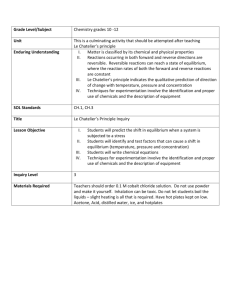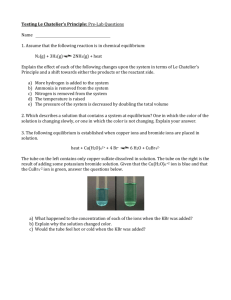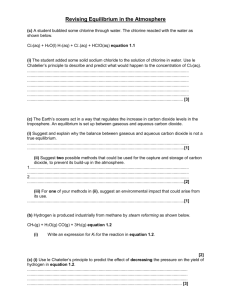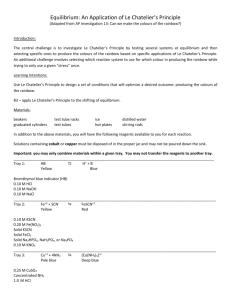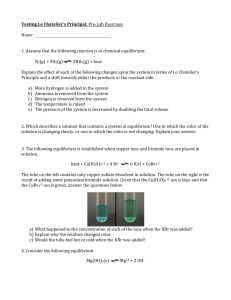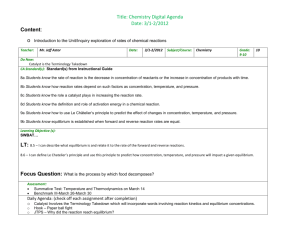Le Chatelier`s Principle in Iron Thiocyanate Equilibrium
advertisement
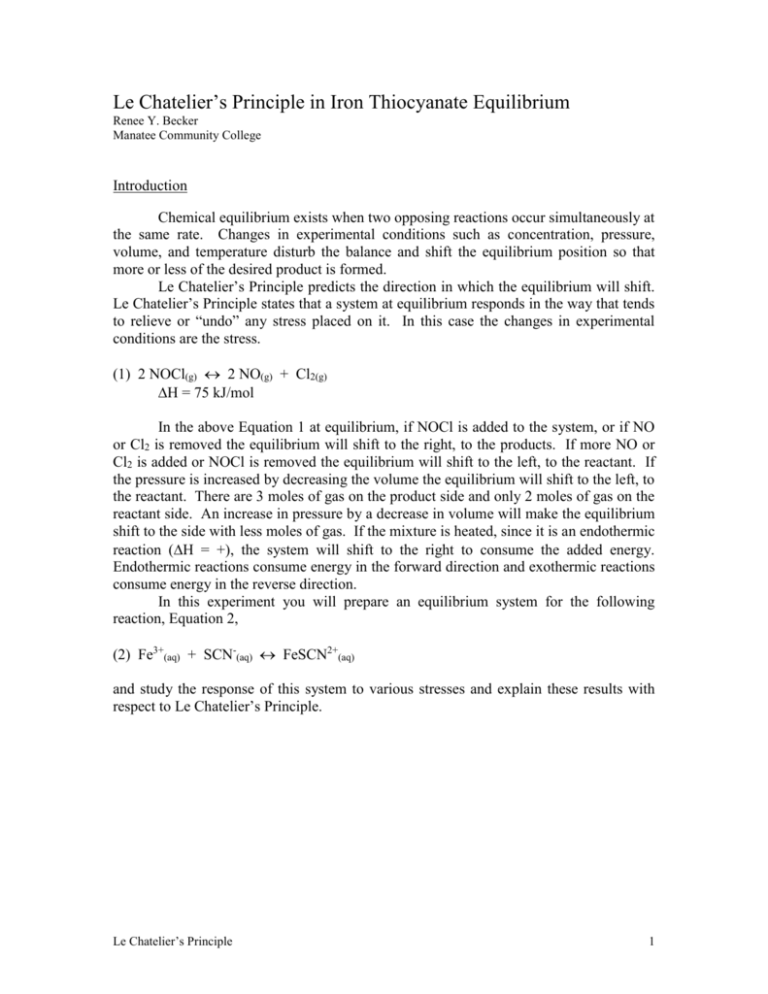
Le Chatelier’s Principle in Iron Thiocyanate Equilibrium Renee Y. Becker Manatee Community College Introduction Chemical equilibrium exists when two opposing reactions occur simultaneously at the same rate. Changes in experimental conditions such as concentration, pressure, volume, and temperature disturb the balance and shift the equilibrium position so that more or less of the desired product is formed. Le Chatelier’s Principle predicts the direction in which the equilibrium will shift. Le Chatelier’s Principle states that a system at equilibrium responds in the way that tends to relieve or “undo” any stress placed on it. In this case the changes in experimental conditions are the stress. (1) 2 NOCl(g) 2 NO(g) + Cl2(g) H = 75 kJ/mol In the above Equation 1 at equilibrium, if NOCl is added to the system, or if NO or Cl2 is removed the equilibrium will shift to the right, to the products. If more NO or Cl2 is added or NOCl is removed the equilibrium will shift to the left, to the reactant. If the pressure is increased by decreasing the volume the equilibrium will shift to the left, to the reactant. There are 3 moles of gas on the product side and only 2 moles of gas on the reactant side. An increase in pressure by a decrease in volume will make the equilibrium shift to the side with less moles of gas. If the mixture is heated, since it is an endothermic reaction (H = +), the system will shift to the right to consume the added energy. Endothermic reactions consume energy in the forward direction and exothermic reactions consume energy in the reverse direction. In this experiment you will prepare an equilibrium system for the following reaction, Equation 2, (2) Fe3+(aq) + SCN-(aq) FeSCN2+(aq) and study the response of this system to various stresses and explain these results with respect to Le Chatelier’s Principle. Le Chatelier’s Principle 1 Procedure 1. Obtain 250 mL DI H2O, 1 mL 1M KSCN, and 1 mL 1M Fe(NO3)3 in a clean, labeled 400 mL beaker (this stock solution should be deep red due to the formation of FeSCN2+). 2. Obtain 10 clean, medium sized test tubes and label 1-10. 3. Add 10 mL of your stock solution to each test tube using a graduated cylinder. 4. Keep test tube number one as a control and add the following reagents (see Table 1) to tubes 2-9 Table 1: Contents of Test Tubes 2-9 Test Tube Reagent Volume 2 1 M Fe(NO3)3 2 mL 3 1 M KSCN 1 mL 4 .1 M AgNO3 .5 mL 5 6 M HCl 2 mL 6 .1 M Hg(NO3)2 .5 mL 7 1 M Na3PO4 1 mL 8 .1 M Na2C2O4 1 mL 9 NaF Few crystals 5. 6. 7. Cover each test tube with parafilm and shake to mix thoroughly. Heat test tube 10 in a hot water bath Compare the color intensity of each test tube with test tube 1 ( the control). a) The test tube with the darkest color has the highest concentration of FeSCN2+. In each test record your observations and explain the results in terms of Le Chatelier’s Principle. Use the complexes and precipitates in Table 2 to explain your observations. Table 2: Complexes and Precipitates Ag+ Hg2+ ClFe3+ ----FeCl4SCN- AgSCN(s) Hg(SCN)42--- PO43FePO4(s) --- FFeF63--- C2O42Fe(C2O4)33--- Disposal Dispose of any excess stock solution and the contents in all test tubes into the proper labeled waste container. Le Chatelier’s Principle 2 DATA Test Tube # 1 Reagent Added Observation Explanation KSCN Fe(NO3)3 2 3 4 5 6 7 8 9 10 Heated KSCN Fe(NO3)3 Le Chatelier’s Principle 3 Pre-lab Questions 1. a) Write down the equilibrium constant expression for the following reaction: Co2+(aq) + 4 Cl-(aq) CoCl42-(aq) b) In which direction will the equilibrium shift if you 2. I. Add Cl- II. Add CoCl42- III. Remove Co2+ Predict the direction of the net reaction in each of the following equilibrium systems as a result of increasing the pressure by decreasing the volume I. H2(g) + I2(g) 2 HI(g) II. 2 SO3(g) 2 SO2(g) + O2(g) III. CO(g) + H2(g) C(s) + H2O(g) Le Chatelier’s Principle 4 3. What effect does an increase in temperature have on each of the following systems in equilibrium? I. H2(g) + I2(g) 2 HI(g) H = -9.45 kJ/mol II. 2 SO3(g) 2 SO2(g) + O2(g) H = 198 kJ/mol III. CO(g) + H2(g) C(s) + H2O(g) H = -131 kJ/mol Le Chatelier’s Principle 5 Post-Lab Questions 1. Write the equilibrium expression for the reaction featured in this lab (2). 2. Is this reaction endothermic or exothermic? Back it up with your observations from test tube 10 3. Write net ionic equations that occur upon addition of the reagents in test tubes 4 to 9. DO NOT include reaction (2) as the net ionic equation. Use Table 2 to do this. 4 5 6 7 8 9 Le Chatelier’s Principle 6

